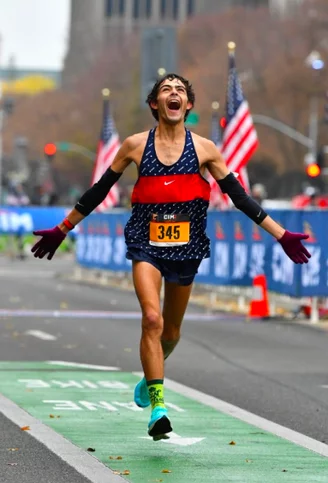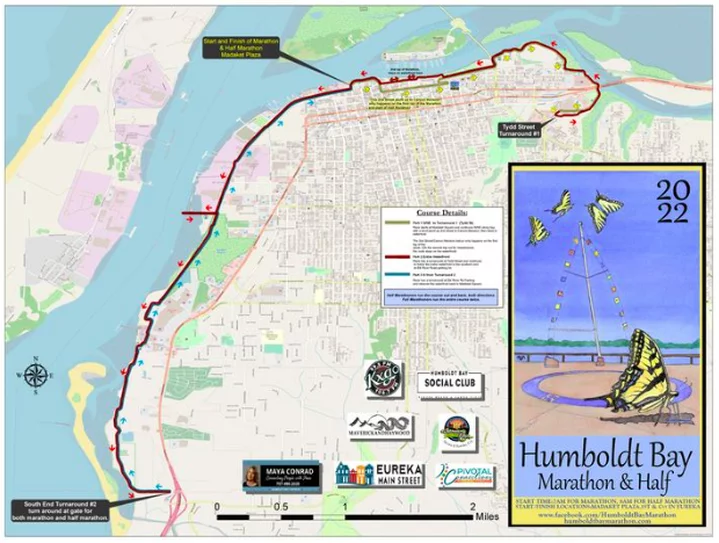Patrick Hutton has been racing in marathons across the country for the last nine years, and this weekend he will run his first ever course in beautiful Humboldt County – the Humboldt Bay Marathon in Eureka – and he intends to break the current course record.
“I’m excited to come out there and hungry to run fast,” Hutton told the Outpost in a phone interview Thursday afternoon.
Originally from San Diego and now living in Flagstaff, Arizona, 30-year-old Hutton trains every day, running up to three times per day and roughly 120 miles per week, he told the Outpost. When he isn’t doing his own training, Hutton professionally trains other marathon runners.
Hutton said he is excited for the Humboldt Bay Marathon course, a 26.2-mile route that runs along the Waterfront Trail, because of the flatness of the trail and the coolness of North Coast climate – two conditions that make this an ideal course for him to break his personal best time of 2:24:45 (two hours, 24 minutes, 25 seconds). Hutton tries to break his own record during each marathon, getting closer to his goal of 2 hours 18 minutes – the time a runner of Hutton’s age and gender needs to qualify for the U.S. Olympic Trials. In December Hutton plans to compete in the California International Marathon, which is an Olympic trial qualifier, meaning that if he competes that course in 2:18:00 or less, he could be one of the 200 runners who qualify for the next Olympic Trials. Out of those 200, only three will move on to compete in the Olympic Games.
Based on the course conditions and his own training, Hutton expects to finish the Humboldt Bay Marathon in about two hours, 22 minutes, which will not only be his personal best but also break the course record of two hours, 33 minutes and five seconds, set by Jochen Uhrig in 2018.
The marathon course starts at Madaket Plaza and runs north, mostly following the Waterfront Trail up to Tydd Street, then back down to the Waterfront Trail south to the end of the Hikshari’ Trail and, finally, back to Madaket Plaza. Those running the half marathon (13.1 miles) will complete the course once and those doing the full marathon (26.2 miles) will complete the course twice. There will be aid stations, with water and other supplies available, about every two miles.
If you are an avid marathon runner, you are probably already aware that 26.2 miles is the standard marathon distance. But for those who don’t know much about running (like this sluggish reporter), then you might be wondering: Why this specific length? According to History.com, the marathon length was initially set at 40 kilometers (about 24.85 miles) to honor the legend of a Greek messenger who ran the distance from the city of Marathon to Athens in 40 B.C. to announce Greece’s victory over the invading Persian army. Legend has it that after the Greek messenger ran the roughly 40 kilometers between the two cities he collapsed and died.
For the next several Olympics, the marathon length remained at 40 kilometers, until 1908 during the Olympic Games in London, when the length of the race was changed to accommodate the British royal family. Allegedly, Queen Alexandra requested that the race start on the lawn of the Windsor Castle and finish in front of the royal box at the Olympic stadium – a distance of 42.195 kilometers, or 26.2 miles. For some reason, the increase in length stuck and in 1921 the length of a marathon was standardized to 26.2 miles. (The Outpost hopes you enjoyed today’s random history lesson.)
Map of the Humboldt Bay Marathon Course. Click this link for a larger, zoomable map.
Of course, to run the impressive distance of 26.2 miles takes a great deal of training and endurance. Those who are not up to such a long run might prefer the half marathon, which is usually a more popular choice. Terri Little, co-director of the Humboldt Bay Marathon, said that about 100 people are registered for the full marathon, and about 200 are registered for the half marathon.
This is a pretty small number compared to some of Humboldt’s larger and more well-known races, like the Avenue of the Giants and the Humboldt Redwoods marathons, which both generally have about 1,000 participants. But Little said this is considered a good turnout and that many people are coming from out of town to participate. One of the biggest draws to this marathon is the weather, with temperatures expected to run from the mid 50s to mid 60s.
“That’s part of why we’re doing it in August, because pretty much everywhere else in the country is super hot and miserable,” Little told the Outpost. “People can come here and run in fairly cool weather.”
Another draw for the Humboldt Bay Marathon is that it’s a Boston Qualifier, Little said, meaning that runners can use their time from this course to qualify for the Boston Marathon. Times needed to qualify vary depending on age and sex and on how many people apply. So beating your qualified time by a larger amount makes you more likely to be accepted into the marathon.
“Qualifying for Boston is a big deal,” Little said. “People strive for that.”
The deadline to sign up for the Humboldt Bay Marathon online has already passed, but late registration will be available on Saturday, Aug. 13 between 4 and 7 p.m. As of Thursday evening, there were still some spots available for both the full and half marathon. The marathon starts at 7 a.m. on Sunday, Aug. 14.
And if you enjoy running but a marathon isn’t your thing, the organizers are also supporting a 5K fun run hosted by Kelly Ridgeway, a survivor of Spontaneous Bilateral Vertebral Artery Dissection (VAD). The run starts at Madaket Plaza on Saturday, Aug. 13 at 3 p.m. Sign-up costs $25 and proceeds will go toward to Teddy’s Team – a non-profit dedicated to raising awareness for stroke and heart disease.
You can find more information on the marathon and the fun run on Humboldt Bay Marathon’s website.


CLICK TO MANAGE